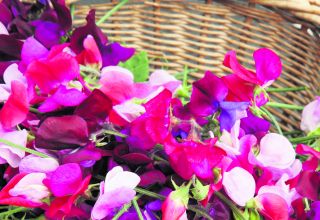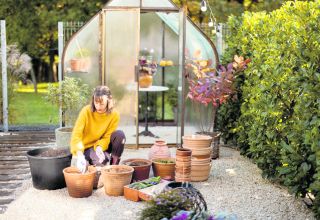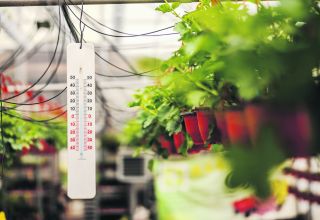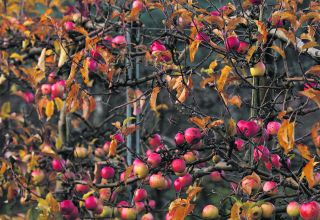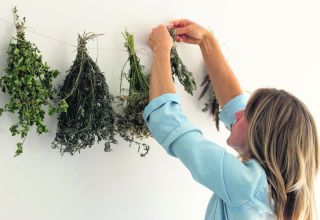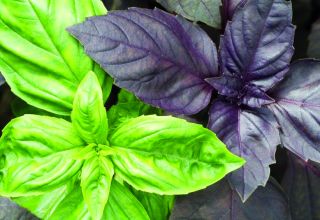Sweet, succulent figs may sound like exotic treats for warmer climes, but if you choose the right variety, you can enjoy home-grown figs in a mild, sunny site.
Who’d have thought that figs would be one of the easiest fruits to grow?
They’re undemanding, hardy and productive, and as they grow best in pots, a fig is the ideal patio tree.
When they’re this good and this straightforward to grow, what could be better than growing your own figs?
Where to plant
Fig trees grow best and produce more fruit when their roots are restricted. This means that the ideal way to grow them is in large pots. Position them against a sunny south or east facing wall in a warm, sheltered area. If you’d rather grow your fig tree in the ground, you will need to bury rubble or paving slabs around the tree to get the same effect. The tree will also be happy in a conservatory or greenhouse if it gets plenty of light and warmth. A position in full sun is best, although most varieties will cope with a little light shade in the afternoon.
The best soil is loamy, well-draining and fertile – this describes most ordinary garden soils, but if yours is on the heavy or sandy side, you can enrich it by digging in plenty of compost.
New fig trees may need to be watered more frequently until the root system is established (in roughly a year), but after that they are drought tolerant and will only need watering in hot, dry weather.
Feed your fig trees weekly with tomato food or general-purpose fertiliser once the fruits start to appear. Your trees will also benefit from an annual mulch of manure or well-rotted compost to discourage weeds and add nutrients to the soil.
Protecting your fruit
In really cold weather, fig trees need protecting – this is particularly important for young trees. Cover the branches with horticultural fleece or bubble wrap or if your tree is in a pot, move it indoors to a shed or greenhouse. Move it back outside in spring and give your tree a good mulch to stimulate new growth.
Pruning fig trees
To keep your fig trees tidy, well-shaped and producing fruit, aim to prune them twice a year, removing dead or weak branches in winter and trimming them lightly into shape in the summer. You may not have to do all this every year, but a pruning session is a good opportunity to check your tree’s progress and detect any problems early on. You should avoid pruning fig trees in spring as they can bleed sap, weakening the tree.
Harvesting figs
A container grown or bare root fig tree will start to produce fruit after just a year, and you should see a decent sized harvest the year after. Once it’s established, a fig tree is capable of producing up to fifty fruits per season!
Figs are ready to harvest when they’re soft, the neck of the fruit starts to wilt and the fruits hang down. This is typically between late summer and towards autumn. Because ripe figs are quite delicate and bruise easily, you should always pick them carefully and handle them as little as possible. Wait until they’re fully ripe, as they won’t ripen any further once picked. To pick your figs, gently pull or cut the fruit from the stem, leaving some of the stem attached if you can, as this makes them last longer.
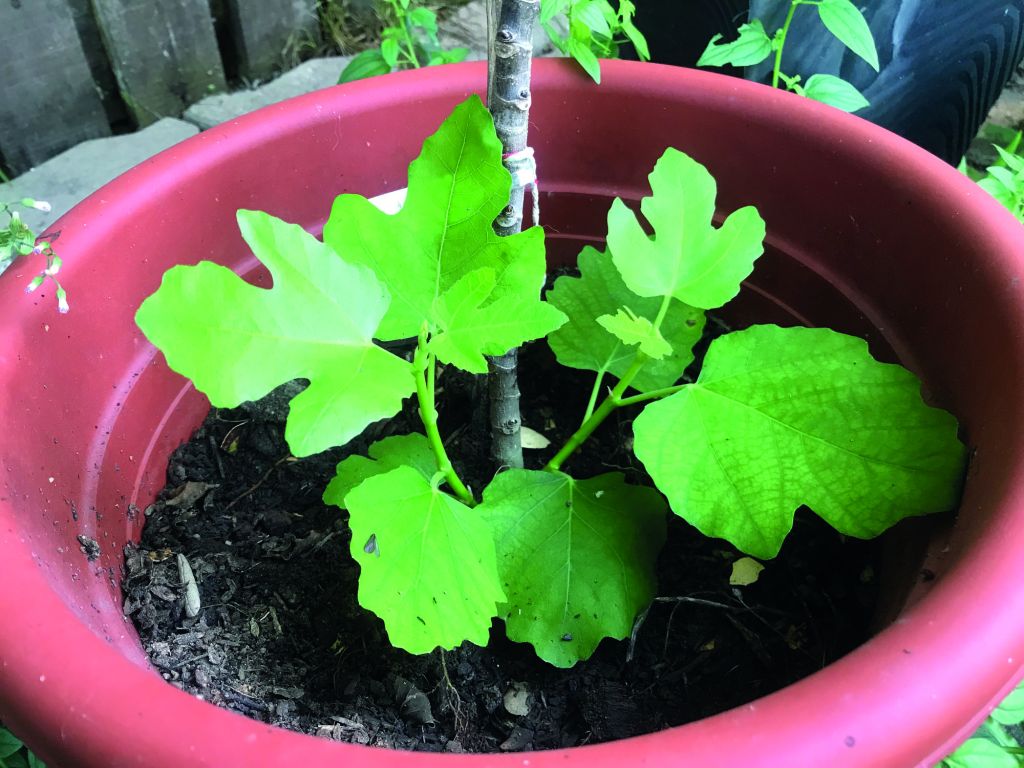
Growing fig trees in pots
If you chose to grow your tree in a pot, choose a large, deep one at least 30cm deep and wide.
Put a layer of broken crockery or gravel in the bottom of the pot and add compost to fill a third to a half of the pot. Take your fig tree out of its nursery pot or ecowrap and loosen the roots if needed. Fill in the pot with compost and firm down.
Trees in pots will need more regular watering and feeding than those in the ground and will benefit from a fresh layer of mulch at the top of the pot every year. Aim to re-pot your tree every two years into a larger container. Signs that your tree is outgrowing its pot include:
Soil drying out quicker than it used to.
Roots poking out through the drainage holes.
The tree looks miserable – the leaves may be yellowing or the crop not as good as it used to be.
Choose a pot at least 25per-cent larger than the previous one and use fresh compost every time.
Growing a fig tree from seed
It can take seed grown figs many years to produce fruit – but for the gardener with a bit of time it’s worth a go? You can collect your fig seeds by scraping them out of a ripe fig. Rinse them and let them dry, then you’re ready to start.
Plant seeds in a small pot of compost or potting mix, about one cm deep. Water the soil to moisten it, but don’t overwater or your seeds could rot.
Cover the pot with a plastic bag or plastic bottle with the bottom cut off, then place your pot in a sunny, warm spot .Seedlings should start to appear in a few weeks to a few months. When this happens, you can take off the plastic cover.When your plants are large enough, you can pot them on into bigger containers. Keep growing them indoors until they’re about 30cm tall and have a few pairs of leaves, then plant them in their final position in a large pot or in the ground.
Three to grow
Brown Turkey – best for beginners
Brown Turkey grows well – it’s resistant to most pests and diseases and it crops better than any fig in the UK. It’s compact – you can grow it in a pot or train it up a wall – and has the reputation of the best taste of any fig.
Brunswick Fig – best for cold areas
This is a great choice for colder parts of the country or even garden, as they’re hardy down to at least -5°C. They’re naturally small, ideal for container growing and in a hot summer, they’ll produce two crops per year.
‘Little Miss Figgy’ – best for smaller spaces
This pocket sized fig tree grows to just 1.2m x 1.2m, making it a great choice for patio pots and smaller spaces including balconies and conservatories. The fruit crop isn’t small however – you’ll still get loads of sweet and delicious figs.
Q&A on growing figs
What month are figs ripe in the UK?
Figs can produce several stages of crop simultaneously but usually, only one crop will ripen in late September. The tiny, pea-sized embryo fruitlets formed in the autumn are next year’s harvest – they will overwinter to produce a crop of figs the following year.
Do figs do well in pots?
Figs thrive in containers and are an excellent option for gardeners with limited space. If you live in an apartment with only a balcony or reside in a cold climate where winter temperatures drop significantly, container gardening might be your best bet.
How can you make figs grow bigger?
If growers can maximise the growth area and reduce the number of fruits on the tree, then the existing fruits will likely grow larger. Ultimately, the balance of energy within the tree plays a crucial role in determining fig size.
Why are my figs so small?
Not enough water is a common reason for small figs on a fig tree. Fig trees need consistent moisture, especially during the growing season. If the tree doesn’t receive enough water, the figs will remain small or drop off prematurely.
Why don’t my figs ripen?
Fig trees are very susceptible to stress and when under stress, they will slow down or even stop ripening their fruit. The most common stress responsible for when figs don’t ripen is lack of water especially when the weather is warm. Fig trees in containers are especially prone to this.
Where is the best place to plant a fig tree?
The ideal location for planting a fig tree in the UK is a warm, sunny, and sheltered spot, ideally against a south-facing wall. This provides the tree with maximum sunlight and heat retention, which are essential for fruiting and ripening in the UK’s climate.

